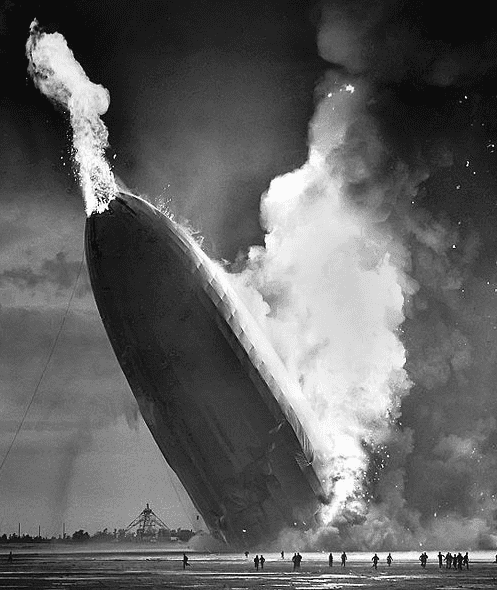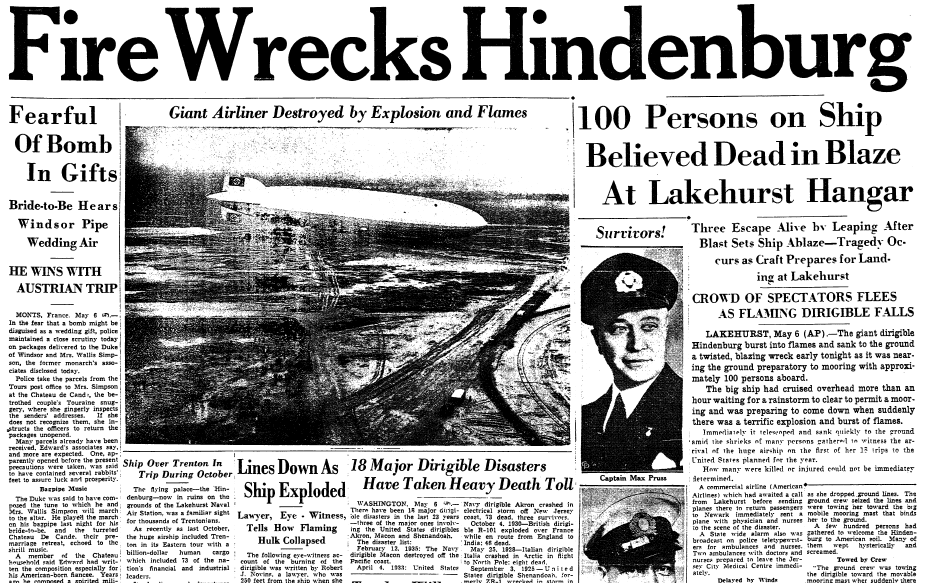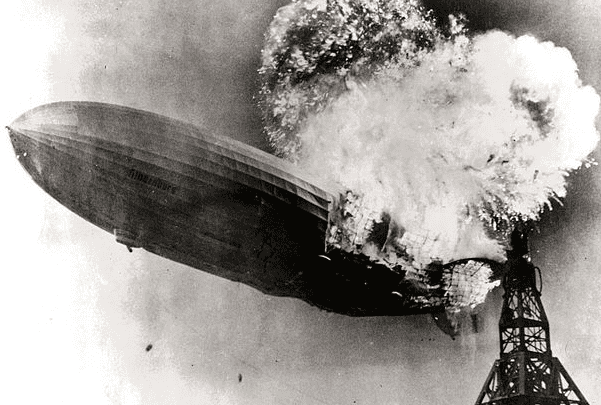It had been an uneventful trip for the 36 passengers and 61 crewmembers who crossed the North Atlantic in the giant airship Hindenburg, leaving Frankfurt, Germany, on 3 May 1937 and now approaching the coastline of America. While waiting out an afternoon thunderstorm before landing on May 6, Captain Max Pruss steered the ship over Manhattan to give the passengers a spectacular view. At 6:22 p.m. the storm moved away, and the Hindenburg headed toward Lakehurst Naval Air Station in New Jersey, its final destination.

It was the first transatlantic crossing of the 1937 season, and a number of journalists were on hand to watch the incredible sight of this huge dirigible being attached to a mooring post and winched down to the ground. The passengers were clustered at the windows of the observation deck, laughing and waving to the people below. Suddenly disaster struck: at 7:25 p.m. the ship exploded, burst into flames, and crashed to the ground – a giant pile of burning bodies, fabric and framework. Thirty-five people aboard the Hindenburg died in the disaster, as well as one member of the ground crew.
Even though several newsreels were made of the landing, they were all focusing on the ground crew when the explosion first occurred, and there is no way of knowing where the flames first appeared – eyewitness accounts differ on this key fact. We do not know what caused the accident, and probably never will. One thing is clear, however: the newsreels and photographs of the accident, as well as the famous radio broadcast by Herbert Morrison, terrified the public away from ever trusting airships again, and the era of the giant dirigible passenger ship was over.
This front page article was published with a huge headline by the Trenton Evening Times.

Here is a transcription of this article:
Fire Wrecks Hindenburg
100 Persons on Ship Believed Dead in Blaze at Lakehurst Hangar
Three Escape Alive by Leaping after Blast Sets Ship Ablaze—Tragedy Occurs as Craft Prepares for Landing at Lakehurst
Crowd of Spectators Flees as Flaming Dirigible Falls
Lakehurst, May 6 (AP)—The giant dirigible Hindenburg burst into flames and sank to the ground a twisted, blazing wreck early tonight as it was nearing the ground preparatory to mooring with approximately 100 persons aboard.
The big ship had cruised overhead more than an hour waiting for a rainstorm to clear to permit a mooring and was preparing to come down when suddenly there was a terrific explosion and burst of flames.
Immediately it telescoped and sank quickly to the ground amid the shrieks of many persons gathered to witness the arrival of the huge airship on the first of her 18 trips to the United States planned for the year.
How many were killed or injured could not be immediately determined.
A commercial airline (American Airlines) which had awaited a call from Lakehurst before sending planes there to return passengers to Newark immediately sent a plane with physicians and nurses to the scene of the disaster.
A statewide alarm also was broadcast on police teletypewriters for ambulances and nurses. Two ambulances with doctors and nurses prepared to leave the Jersey City Medical Centre immediately.
Delayed by Winds
The Hindenburg was scheduled to arrive early today but strong headwinds over the Atlantic delayed her and it was mid-afternoon before she passed over New York City.
She cruised over Northern Jersey waiting for a 5 P.M. (Eastern Standard Time) mooring. The ground crew had been instructed to report at that time.
Then she was sighted approaching the Lakehurst air station but a rainstorm had come up meanwhile and she was forced to cruise about still longer.
Two stewards and a little cabin boy, who refused to give their names, escaped. They said the explosion came from the stern of the ship and they saved themselves by jumping from the windows.
Watchers near the mooring tower said the ship was only a few hundred feet from the ground, and passengers were laughing and waving from the observation windows when the bomb-like explosion sent out clouds of red and black, billowing smoke.
Harry Wellbrook, of Toms River, a member of the ground crew directly under the stern waiting for the landing lines to be thrown, said he and the men in the crew ran for their lives to keep away from the blazing wreckage.
After the dirigible struck the ground and they returned, they tried to bring survivors from the wreckage.
He said, “We got out three bodies from the stern of the ship all burned beyond recognition. One of the men was so horribly burned that the features were not recognizable. Only by the fact that he was still breathing could we tell he was alive. The clothing on all of these bodies was burned to cinders and the skin scorched off.”
Rescue work was being conducted by an Army detail from Philadelphia which was on the ground for an emergency.
The Hindenburg was making her first North Atlantic crossing of the season.
Robert J. Novins, a lawyer, was 250 feet away from the big ship as she dropped ground lines. The ground crew seized the lines and were towing her toward the big mobile mooring mast that binds her to the ground.
A few hundred persons had gathered to welcome the Hindenburg to American soil. Many of them wept hysterically and screamed.
Towed by Crew
“The ground crew was towing the dirigible toward the movable mooring mast when suddenly there was a spurt of flame from the middle section of the airship,” Novins said. “The flame was a little back from the exact centre toward the rear. Then there was an explosion and the whole ship seemed to be in flames. It seemed as though some of the ground crew members were caught in the flames.”
Captain Ernst Lehmann, veteran of many Atlantic crossings on dirigibles, was aboard the Hindenburg, but he was there in an advisory capacity. Captain Pruss, former first officer, who moved into command when Lehmann was assigned to designing and construction work in Germany, was in actual command.
Note: Click here to see a YouTube video of newsreel footage of the Hindenburg disaster (synchronized with Herbert Morrison’s famous radio description that was recorded on May 6 but not actually broadcast until the next day): https://www.youtube.com/watch?v=jH-mhZLuGRk
An online collection of newspapers, such as GenealogyBank’s Historical Newspaper Archives, is not only a great way to learn about the lives of your ancestors – the old newspaper articles also help you understand American history and the times your ancestors lived in, and the news they talked about and read in their local papers. Were any of your ancestors involved in the Hindenburg disaster? Please share your stories with us in the comments.
Explore over 330 years of newspapers and historical records in GenealogyBank. Discover your family story! Start a 7-Day Free Trial
